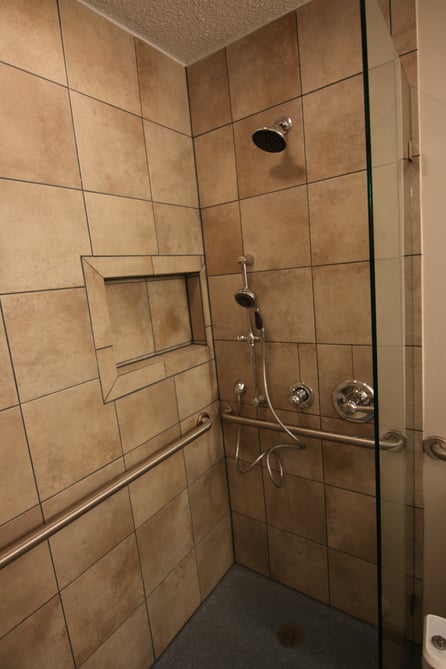Aging in place is about the need and necessity to create and implement accessible and adaptable designs for a home no matter the age or physical condition of the occupants. There are a significant number of aging Americans who have the motivation to stay active and live longer in a home that has provided safety, privacy, and independence to them as they have aged. Births rose at an incredible rate between 1946 and 1965 creating the baby boomer sector of the population. Acknowledgement of this aging phenomena began taking shape in the early to mid 1990's as a new type of housing needs were being discovered. This group of people tells the real story of the present day evolution in thought behind the world of home construction and remodeling. These forgotten folk's needs are far beyond the Americans With Disability Act known as the ADA used for helping with handicap accessibility and the new concept of Universal Design. The ADA rules gave accessibility to everyone in a public place. Universal design encompasses the need for understanding the human body as it develops within a dwelling and has brought about a new type of housing which is accessible to all generations no matter their age or physical limitations.
Universal design takes care of newer homes in today's inventory but what about the rest of the homes whose architecture represented the antiquated thoughts of designers and builders in the past. The architects of these times assumed everyone would live forever with total mobility. Fortunately for the dwellers of these older homes an educated group of home remodelers has emerged to solve the problems of accessibility. Certified Aging In Place Specialists are needed and available scattered throughout the remodeling industry to help with the architectural malfunction and lack of maneuverability in these homes. CAPS specialists can assess your home identifying the problems, redesign the most used spaces like the bathroom, kitchen, and living area to increase your accessibility, and carry out the home modifications which have been proposed.
ADA Compliant Showers

The National Association of Home Builders, in partnership with the AARP and Home Innovation Research Labs, created the CAPS program, which includes training and education on the technical, business management and customer service skills essential to compete in the fastest growing segment of the residential remodeling industry--home modifications for aging in place. David L. Traut, CAPS owner of T-Square Company in Austin, Texas as a handicap remodeling contractor is one of the select group of professionals nationwide to earn the Certified Aging-In-Place Specialist (CAPS) designation, identifying him as a home remodeler and builder with the skills, training, and knowledge necessary to design and remodel or modify a home to meet the unique needs of the older population, disabled owners, or their visitors.
There are really three categories of aging in place customers. Those who are simply and wisely planning ahead for their futures to remain in their present homes. The second category concerns those people who know they have a chronic medical disorder and need to prepare in advance for accessibility issues which will come as a result of their disease. People with diseases that are constantly causing increased physical or mental changes to their being are a good representative of this second group. The third group involves those people who either have had a chronic problem that has progressed severely altering their mobility or those who have sustained a life altering tragedy such as being involved in an accident. All of these groups will drive the future metamorphosis of existing inaccessible dwellings.
Elder construction most definitely falls under the category of aging in place. People are living significantly longer with the advent of specialized medicine, care, and a healthier lifestyle. The Center for Disease Control defines aging in place as the ability to live in one’s own home and community safely, independently, and comfortably regardless of age, income, or ability level. Aging in place construction and remodeling has become synonymous with handicap accessible home design and modification during our lifetime. Home modifications can be used to accommodate anyone from people with mobility impairments to those with vision loss, hearing loss, or even cognitive or developmental disabilities. Accessibility home modifications or wheelchair accessible kitchen and bathroom remodeling in Austin will allow anyone with limited mobility within your home to feel more empowered and independent. The extent of a customized accessibility design is dependent upon the activity level of the person requiring the modifications. Whether someone needs a cane, walker, or wheelchair to help with mobility it is definitely a game changer for accessibility within the home. Aging in place home modifications help people maintain their living environment for as long as it works for them before they might need assisted living care or a nursing home.
For additional information about the CAPS program, visit nahb.org/CAPS. For more information about T-Square Company, visit www.tsquareco.com or call 512-444-0097.












